MODULE 3
ABSTRACTION FROM PRECIPITATION
- The process of transformation of the liquid water into gasified form is named evaporation. The rate of evaporation is usually depends on (1) the vapor pressures at the water surface and air above, (2) air and water temperatures, (3) wind speed (4) atmospheric pressure, (5) quality do water, (6) depth of water body and (7) shape and size of water body.
Vapor Pressure:
- The rate of evaporation is proportional to the difference between the saturation vapor pressure (eu) at a existing water temperature, and a existing actual vapor pressure in the air, ea.
The relationship is given by:
EL =C (eu -ea)............ Dalton's law
Where, EL =rate of evaporation (mm/day), C= a constant; and eu and ea. Are in mm of mercury. Evaporation continues till eu =ea and if eu <ea, condensation takes place.
Temperature:
- The different issue remains same, the speed of evaporation will increase with a rise within the water temperature.
Wind:
- Wind aids in removing the gaseous water vapour from the zone of evaporation therefore increase in wind speed increases the scope of a evaporation. However, if the wind rate is massive enough to get rid of all the evaporated water vapor (critical wind speed), any longer increase in wind velocity don't influences the rate of evaporation.
- This crucial wind-speed worth may be a operate of size of the water surface.
- Massive water bodies high speed turbulent winds are required to cause the most rate of evaporation.

Atmospheric Pressure:
- Other factors like heat input remaining same, there's decrease within the measuring system pressure, as in high altitudes, will increase evaporation.
Water Quality:
- The rate of evaporation from the water surfaces exposed to identical climate could vary consistent with the standard of water available. For example, evaporation is decreases by a ship one p.c for each 1 percent increase in salinity, so evaporation from ocean water with the typical salinity of regarding 3.5 p.c is a few two to three percent below the evaporation from H2O at a same temperature.
Depth of Water Body:
- For the shallow water body seasonal temperature of a water matches therewith of air above. This suggests that most rates of evaporation from a shallow water body are experienced throughout the summer months. During a case of the massive trouble body, however, water temperatures usually lag behind the temperatures of a superimposed air.
- During a spring and early summer months goodly depths of water are slowly and bit by bit warm up by a locality of a incoming solar power which might somewhat be on the market for evaporation. Afterward the slow unharness of this keep heat, by a trouble body throughout the season and winter months, implies that provide a heat energy of that received directly from the sun is formed available for evaporation at that point of the year.
- Hence highest rates of the evaporation from deep water bodies occur during the winter season. Furthermore, during winters, water vapor-laden air ought to be quickly raised aloof from that underlying water surface because the results of convectional activity inspired by the gradient, whereas during the summer, the colder water will tend to chill Associate in Nursing stabilize an air forthwith higher than it and then inhibit the removal of vapor laden air.
- However, the result of warmth storage was primarily to alter the seasonal evaporation rates and also the annual evaporation rate is to be rarely affected.
- Size and form of Water Surface:
- Air moving across the massive lake has been low tide vapor content at the upwind edge and evaporation from the lake surface will bit by bit will increase the water content. Therefore the vapor blanket is made over a lake, the thickness of that increases in windward direction. There'll be decrease within the rate of evaporation because the vapor blanket up-to-date with water surface will increase in thickness. Thus, as larger the lake, the larger can be the overall reduction in evaporation of water.
- In the case of the continual water surface, For eg, the oceans, evaporation rural area be uniform over abundant larger areas. However small evaporating surfaces reminiscent of evaporimeters and pans exert very little influence on the humidness of the superimposed air. The little quantity of a vapour that leaves the surface, even with higher rates of evaporation, which is quickly dissipated as a lot of dry air moves in and in this way; a continual high rate of evaporation is maintained.
- The quantity of water gaseous from a water surface is calculable by the subsequent methods:
(1)Using evaporimeter data
(2)Using empirical evaporation equations
(3) Analytical methods.
- Evaporimeters are water-containing pans that are espoused to the atmosphere, and also the loss of a water by evaporation in them are measured at regular intervals.
TYPES OF EVAPORIMETER:
- Class A Evaporation pan (US Weather Bureau)
- ISI commonplace Pan (Used in India)
- Colorado Sunken Pan (Pan is undone below ground in such how that water level in Pan are going to be at ground level)
- US geologic Survey Floating Pan (Simulates the characterization of huge water body. The evaporimeter will be unbroken floating in lake).
Pan constant (Cp):
- Evaporation pans won't be precise models of the big reservoirs.
- In read of the above, the evaporation discovered from a pan has been corrected to get the worth of a evaporation from a lake beneath similar environmental condition and exposure conditions. Thus, a coefficient (C) is introduced as shown below.
SR NO | TYPES OF PLAN | AVERAGE VALUE | RANGE |
1 | Class A land pan | 0.70 | 0.6-0.8 |
2 | ISI pan | 0.80 | 0.64-1.10 |
3 | Colorado sunken pan | 0.78 | 0.75-0.86 |
4 | US GS floating pan | 0.80 | 0.70-0.82 |
Lake evaporation =Cp ×pan evaporation.
Where, Cp= pan coefficient. The values of Cp in use for various pans are given in Table.
Evaporation Stations
- It is incredibly usual to put in associate evaporation pans at such locations wherever different earth science knowledge are at the same time being collected. As per UN agency recommendation.
1. Arid zones - Min of 1 station for each 30,000 km2,
2. Wet temperate climates - Min of one station for every 50,000 km2
3. Cold regions - Min of one station for every 100000 km2
- Methods of estimation of evaporation may be divided into two categories:
(1) Empirical formulae, and
(2) Analytical methods (water budget method, energy balance method, mass transfer method).
1. Empirical Formulae:
- Empirical Formulae are based on Daltons law
Meyer's Formula
EL =KM (we-ea) [1+ (u9/16)]
Where, EL = lake evaporation in mm/day; ew = saturated vapor pressure at the water-surface in mm of mercury; ea =actual vapor pressure of overlying air at a specified height in mm of mercury; u9 = monthly mean wind velocity in km/h at about 9 m above the ground, = 0.36 for giant deep and 0.50 for small, shallow waters.
Often, the wind-velocity knowledge ought to be obtainable at, an elevation on the other hand that required within the explicit equation. However, it's best-known that in the lowest a part of the atmosphere, up to a height of regarding five hundred m higher than the bottom level, the wind speed is assumed to follow the 1/7 law as
Uh =C h1/7
Were uh= wind velocity at a height h (in meter) above the ground in km/hr and C= constant. This equation can be wont to verify the velocity at any desired level if uh is known.
2. Analytical Methods:
- The analytical ways for the determination of the lake evaporation is generally classified into 3 classes as:
(1) Water-budget technique
(2) Energy-balance method and
(3) Mass-transfer method
(1)Water-Budget Method
- The water-budget method is that the simplest method from all three analytical methods and it's conjointly the smallest amount reliable. During this method we've to put in writing the hydrological continuity equation for variety and verify the evaporation from the information or estimation of different variables.
P +Vis +Vig =Vos +Vog +EL +∆S +TL.
Where, P =daily precipitation
Vis =daily surface inflow into the lake.
Vig = daily groundwater inflow
Vos = daily surface outflow from the lake
Vog =daily seepage outflow
EL = daily lake evaporation
∆S = increase in lake storage in a day
TL = daily transpiration loss
(2) Energy-Balance Method
- The energy budget technique uses the law of a conservation of energy. The energy out there for the evaporation is set by considering the incoming energy outgoing energy, and also the energy keep within the water body over a far-famed time interval.
- From the energy available for the evaporation, although worth of the evaporation rate are calculated.
HN =Ha +He +Hg +Hs +Hi
Where, HN = net heat energy received by the water surface,
HN = Hc (1-r)-Ho
Hc (1-r) = incoming solar radiation into a surface
Hb = back radiation
r =reflection coefficient.
Ha = sensible heat transfer from water surface to air,
Hg =heat flux into the ground,
Hs = heat stored in water body.
Hi = net heat conducted out of the system by water flow (adverted energy)
He = heat energy used up in evaporation =pLEL
Where, P = density of water
L = latent heat of evaporation, and
E = evaporation in mm
All the energy terms are in the calories per square mm per day, if the time periods are short, the terms Hs and Hi can be neglected as negligibly small. All the terms except Ha can either be measured or evaluated indirectly. The sensible heat term Ha, which could not be readily measured, which is estimated using Bowen's ratio B given by the following expression:
B= Ho /pLEL =6.1×10-4×po [(Tw -Ta)/(ew -ea)]
Where pa = atmospheric pressure in mm of mercury, ew = saturated vapor pressure in mm of mercury, ea = actual vapor pressure of air in millimeter of mercury, Tw = Temperature of water surface in 0C, and metal = temperature of air in 0C. Thus EL =can be evaluated as ;
EL = Hn -Hg -Hs -Hi /L (1+B)
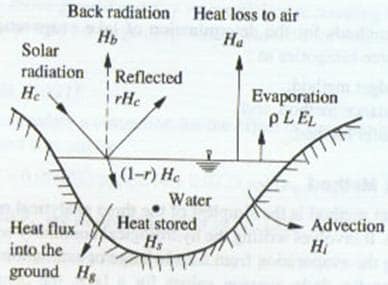
(3) Mass-Transfer Method:
- This method, supported theories of turbulent mass transfer within the boundary layer, permits shrewd the transfer of a mass of water vapour from the surface to surrounding.
- The volume of a water lost thanks to the evaporation from a reservoir during a month are going to be calculated by the formula :
VE = A Epm Cp.
VE = volume of water lost in evaporation throughout a months (m3),
A = average reservoir space (i.e., water spread) during the month (m2).
Epm = pan evaporation loss in meters during a month,
=(EL in mm/day) x (No of days within the month x 10-3), and
Cp =relevant pan coefficient.
The numerous ways on the market for reduction of evaporation losses are going to be thought-about fewer than 3 categories, corresponding to;
Reduction of Surface Area
Since the quantity of the water lost by the evaporation is directly proportional to the area of water body. Deep reservoirs in situ of wider ones will be scale backs evaporation losses.
Mechanical Covers
Permanent roof /temporary roof reduce lake evaporation.
Chemical Films
Certain chemicals such as cetyle alkohol (hexadecanon) and stearyle alcohol (octedecano) forms the layers on a water surface. These layers act as a evaporation inhibitors by preventing the water molecules to flee past them. Application of a skinny chemical film on the water surface reduces the evaporation
- Transpiration have been defined as the process by which the water vapor eichpes from the living plant, principally through its leaves then into the atmosphere. In an area covered with venation it will be difficult and also unnecessary from practical view point to separately evaluate evaporation and transpiration. It will be more convenient to estimate the evapotranspiration directly. Only over those areas of the earth's surface where no vegetation is present will purely evaporation occur. Evapotranspiration represents the most important aspect of the water loss in the hydrologic cycle.
- The term consumptive use would also used to denote this loss by the evapotranspiration. If decent wet is often on the market to the fully meet the wants of vegetation absolutely covering the area, the ensuing evapotranspiration is termed as potential evapotranspiration (PET). Potential evapotranspiration doesn't depend upon the soil and plant factors however depends basically on environmental condition factors. The important evapotranspiration’s occurring in the prevailing/actual condition is called as actual evapotranspiration (AET).
- Field capability is that the most amount of Water that the soil can retain against the force of the gravity. Permanent weakening purpose is the moisture content of the soil at that the plant wilts and does not recover during a wet climate. At this stage, even if the thusil contains some wet, it'll be so command by the soil grains that the roots of area don't seem to be able to extract it in decent quantities to sustain the plants and consequently a plants wilt. The fled capability and permanent wiling purpose rely on the varied soil characteristics. The distinction between these 2 moisture contents is termed as on the market water (a moisture available for plant growth).
- If the soil moisture is at the sector capacity AET =PET If the water system is also below PET, the soil dries place and therefore the magnitude relation AET/PET would be below unity.
- The decrease of the ratio AET PETith on the market wet depends upon the sort of soil and the rate of drying generally, for the clayey soils, ABT/PET= 1.0 for nearly 50% drops during a available moisture. Once a soil moisture reaches the permanent weakening point, the AET are going to be reduces to zero.
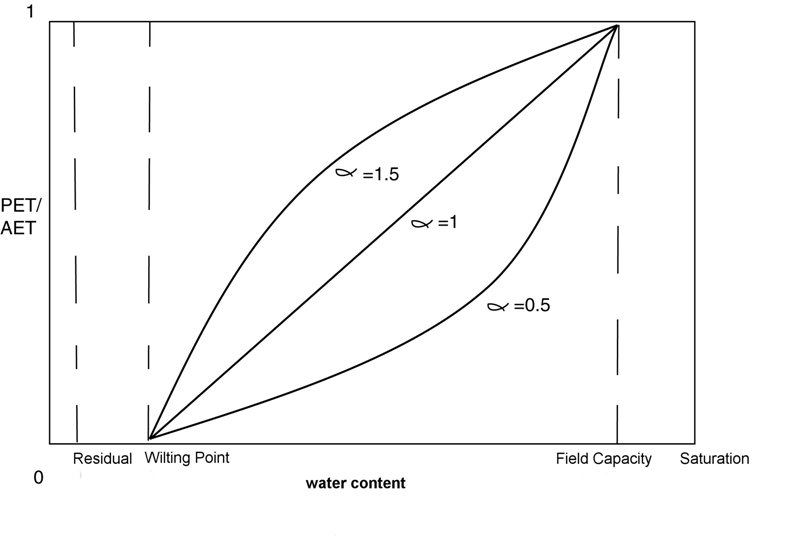
- The measuring of the evapotranspiration for given vegetation sort got to be dispensed in 2 ways: either by mistreatment lysimeters or by a use of the sphere plots.
Phytometer
Measures solely transpiration.
Lysimeter
- A lysimeter (also called evapotranspirometer) consists of the circular will crammed with the soil and individual crops or natural vegetation, that the evapotranspiration is needed . it's buried in order that its high are flush with the encompassing ground surface. The perimeters of the lysimeters are runproof whereas very cheap will be pervious. Water passing through the soil column would be collected at the bottom Associate in Nursing conducted through atiny low tube to the activity gauge in an adjacent pit. Evapotranspiration are calculated as;
AET = Wsi +Wad -Wc -Wsf.
Wsi = original wt of container+ soil+ plant+ water moisture
Wad = water added
Wc = water collected at bottom
Wsf = final wt of container content
Field Experimental Plots:
- In this methodology an irrigation plot is choosen and also the amounts of water added to the irrigation plot by the approach of precipitation and irrigation are measured at the side of the runoff.
- The wet content in Associate in Nursing varied layers of the soil inside the foundation zone depth are measured each at starting and finish of the crop season. Then the evapotranspiration will be computed as:
ET = I -Q - ∆S
- Where i'll be the entire flow in millimeter as well as precipitation and irrigation water, Q will be the total surface runoff in mm and ∆S will be the rise in soil moisture storage in mm.
- Potential evapotranspiration would be observed mistreatment Penman's equation and some empirical formulae.
- Penman's equation will be based on combination of both the energy balance and mass transfer approaches.
PET=A(Hn)+Ea Y/(A+Y)
PET = daily potential evapotranspiration, in mm per day,
A = slope of the saturation vapor pressure vs temperature curve at the mean air temperature, in mm of mercury per 0C
Hn = net radiation, in mm, of evaporable water per day,
Ea = parameter including wind velocity and saturation deficit, and
Paychometric constant = 0.49 mm of mercury/°C.
Empirical Formulae
Blaney-Criddle formula
- This is a purely empirical formula which is based on data from arid western United States. This formula assumes that the PET is said to the hours of sunshine and temperature, which can be taken as a live of the radiation on the given area. The potential evapotranspiration within the crop-growing season is given by the subsequent equation,
Er =2.54 K
Er = PET in a very crop season, in cm,
K= empirical coefficient, counting on the sort of the crop, month and locality
=sum of monthly consumptive use factors for the p
Ph = monthly p.c of annual day-time hours, depending on the latitude of the place and
Tf = mean monthly temperature, in °F.
Isopleths
- The lines on the map through places having equal depths of evapotranspiration.
- Interception is that portion of total precipitation that, whereas falling on the surface of the earth, is intercepted by the surfaces of buildings vegetation cowl on the bottom, roads and pavement and so on and after lost by evaporation.
- The 3 main elements of interception by vegetal cover are outlined below:
- Interception Loss: Water which is preserved on a surface, as mentioned above, and which is later gaseous away.
- Through Fall: Water which can dripe through comes down from the leaves, etc. onto the ground surface.
- Stem Flow: Water which trickles on the branches and eventually down the pain trunk onto the bottom surface.
- Thus, it's solely the interception loss that doesn't reach the ground primary water loss.
- It was found that evergreen trees have additional interception loss than that deciduous ones. Also, dense grasses have nearly same interception loses as full-growth trees and might account for nearly 20% of the entire precipitation within the season. Agricultural crops in their season additionally contributes high interception losses.
Depression Storage:
- When the precipitation of the storm reaches a ground, it must first fill up all depressions before it can be flow over the surface. The volume of the water trapped in this deprecation is called as depression storage.
- Rainfall held in these depressions does not contribute to the surface runoff unless these are filled to capacity. This amount is eventually lost through processes of infiltration and evaporation and thus forms a part of a initial loss.
- Infiltration is that process by which the precipitation moves downward through the surface of a earth and replenishes soil moisture, recharges aquifers, and ultimately supports stream flows during dry periods.
- A distinction will be made between the terms infiltration and percolation, the latter being used to describe the downward flow of the water through 20ne of aeration towards water table, the former being restricted toentry of the water through the surface layers of the soil.
- Along with interception, depression storage, and storm period evaporation (evaporation during rainfall), infiltration determines the availability, if anyof the precipitation input for generating, overland flows.
(Infiltration +Depression storage + Interception) = (Rainfall-Runoff)
- During a major storm, capable of producing a flood, evapotranspiration loss is generally negligible and losses by interception and depression storage are small compared to infiltration.
Hence infiltration+0+ 0= Rainfall -Runoff
- Infiltration continues as long as there will be supply of the water at the soil surface either by direct precipitation or by a flowing sheet of water If the intensity of rainfall is less, all the water infiltrating into the soil gets stored as soil moisture and does not contribute to ground water flow. If however the rainfall intensity will be more, the soil gets saturated and then there after contribution to ground water flow starts.
Factors Affecting Infiltration:
- Infiltration capacity (fc) is defined as the maximum rate at which rain can be absorbed by a soil in the given condition.
- The infiltration process will be affected by the large number of factors as discussed below.
Rainfall Characteristics:
- The actual rate of infiltration, f, at a given time can be expressed,
f=fc when i>fc
f=i,when i <fc
- Where, i is the intensity of rainfall and fc is the infiltration capacity at a given time; i, f and fc are expressed in cm/hr or mm/minute. The infiltration capacity (fc) of a soil is high at the beginning of the storm and has an exponential decay as the time elapses.
Characteristics of Soil:
- A loose permeable sandy soil have a larger infiltration capacity as compared to light clayey soil. Clayey soils may be rendered virtually impermeable due to raindrop compaction, whereas clean sandy soils are much less susceptible to rain compaction.
- A dry soil may absorb more water than that type of soil whose pores are already full of the water.
Surface Cover:
- A vegetation cover tends to increase infiltration by:
(1) Retarding surface flow, and thus allowing more time for water to enter the soil,
(2) Shielding the soil surface from direct impact of rain drops, thereby reducing surface compaction,
Spread of buildings and paved surfaces in urban areas effectively reduces the infiltration capacities, of various patches of ground to zero and thus contributes significantly to frequency of flood peaks in such areas.
Characteristics of infiltrating Water:
- Viscosity of water and, therefore, the ease with which it may move through soil pore spaces, it will varies with water temperature. It is therefore, expected that temperature may tend to exert some influence on the rate of infiltration.
- Infiltration characteristics of the soil, at a given location, can be obtained by conducting controlled experimentation small areas. The experimental set-up termed as an infiltrometer.
- There are two kinds of infiltrometers:
(1) Flooding type infiltrometers, and (2) Rainfall simulator
Note- Infiltration may also be found from hydrograph analysis
Flooding Type Infiltrometer:
- This is simple instrument consisting essentially of the metal cylinder. This cylinder will be driven into the ground to a depth of 50 cm.
- Water will be poured into the top part to the depth of 5 cm and a pointer is set to mark the water level. As infiltration proceeds, the volume is made up by adding water from a burette to keep the water level at the tip of the pointer. Knowing the volume of water added at different time intervals, the plot of the infiltration capacity us time will be obtained.
- A major objection to this simple infiltrometer is that unfiltered water spreads at the outlet from the tube (as shown by dotted lines in the figure), anidas such the tube area will not representative of a area into which the infiltration takes place.
- To overcome this lacuna a ring infiltrometer costing of a set of two concentric rings will used.
- In this infiltrometer two concentric rings are to be inserted into the ground and the water depth will be maintained on the soil surface as discussed above, in both the rings, to a common fixed level.
- The outer ring provides the water jacket to the infiltrating water of the rings, and hence prevent, to a large extent, the spreading out of the infiltrating water with respect to the inner tube. The measurement of water volume will be done for the inner ring only.
The main disadvantages of a flooding type infiltrometer are:
- The raindrop-impact effect will not simulated, and
- The driving of the tube or rings disturbs the soil structure
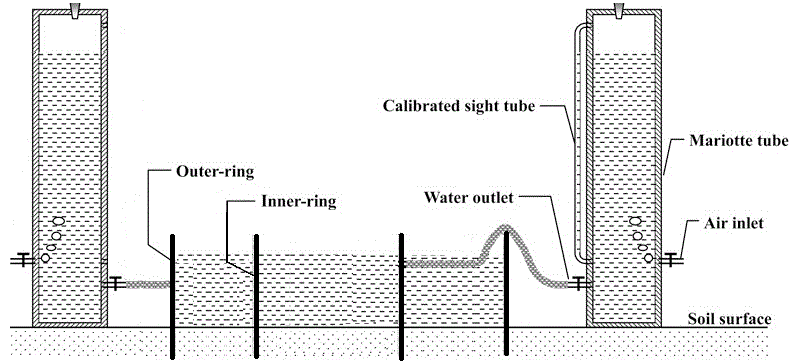
Rainfall Simulator:
- Here, as little plot of land, of regarding 2m x4m activity is furnished a series of nozzles on the longer side, with preparations to accumulate and measure the ground runoff rate.
- The significantly designed nozzles manufacture raindrops falling from the peak of 2 m, and are to boot capable of manufacturing a spread of intensities of rainfall
- Experiments are going to be performed below managed stipulations with a spread of combos of depth and duration, and therefore the resultant surface runoff is measured in every case.
- Using the water-budget equation involving extent of the rainfall, infiltration and runoff, the infiltration charge and its version with time is calculated.
- If the precipitation intensity may bigger than the infiltration rate, infiltration capability values can obtained.
- Rainfall machine kind infiltrometers offer lower values than the that flooding kind infiltrometers this can be thanks to the impact of rainfall influence Associate in Nursing cloudiness of the ground water gift within the former.
Empirical Infiltration Equations:
- Under given soil kind and antecedent wet conditions, there's an initial infiltration rate, f0 This rate will minimize as additional water receives infiltrated, afterwards reaching a Conant rate, atomic number 26 ie, final infiltration capacity. This infiltration ability charge prevails once the soil are going to be saturated. The parameters fo,fe and therefore the decay of infiltration ability are options of the soil wet conditions, vegetation, rainfall, depth and soil surface conditions.
- Several empirical equations incorporating the higher than said factors, touching the conduct of the soil are proposed.
- Green-Ampt Model
- Horton Infiltration Equation
- Huggine- Monka Equation
- Soil Conservation Service Practice
- Antecedent Precipitation Method
- Horton infiltration equation, as an example, is mentioned herein. It seems like,
f = fc (fo-fc)e-at
- Where, in practice, field officer ,fe and a(a constant) are parameters to be calculable from the given data; e is that the napierian base and could be a regular and t are going to be the time from the establishing of precipitation.
- The equation is applicable for exclusively once rainfall a lot of less through retention is larger than or up to time.
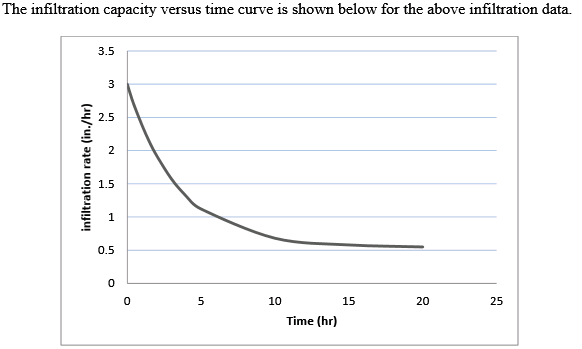
Relation of Infiltration to Runoff:
- During a most significant storm, capable of manufacturing food conditions within the stream basin, evapotranspiration lasses are negligible and losses by means that of interception and depression storage are little in distinction to the amount of infiltrating
- Too low a rate of infiltration causes high runoff and too high fee of infiltration consequences in low runoff
- Infiltration helps to decrease meals and erosion and furnishes flow go together with the flow throughout the intervals of dry weather, and additionally presents water for the expansion of plants as nicely as recharges the bottom water reservoir.
- In hydrological calculations involving floods, it will be placed convenient to use regular fee of infiltration worth for the length of the storm. The typical infiltration price is named as infiltration index and 2 kinds of indices, during these regards are in frequent use.
(1) o-index
- The index have the common downfall higher than that the rainfall extent are capable the runoff volume
- Index have common infiltration charge for the duration of the length of rainfall excess. Downfall additional is that the rainfall causative to runoff and also the amount during which such a rainfall takes space is called period-of rainfall excess.
- The index can be derived from the rainfall hyetograph with the knowledge of the following runoff volume. The preliminary loss can even consider a vicinity of infiltration
- If i< index f=I> index ,f= index.
- In estimating the maximum floods for design purposes, in the absence of any different data, an index cost of 0.10 cm/h might also be assumed.
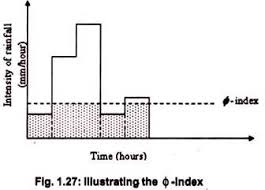
(2)W-Index
- The W-index is the subtle version of index. It will exclude the despair storage and interruption from the whole losses. It has average infiltration charge at some stage in the time rainfall intensity exceeds the capital rate. That is
W= F/t =(P-Q-S)/t
Where F is the whole infiltration, t will be time during which rainfall intensity exceeds infiltration capacity, R will be total precipitation corresponding to t, Q is the whole storm runoff and S is the quantity of depression storage and interception.
W-index is usually much less than the index (W-index < index).